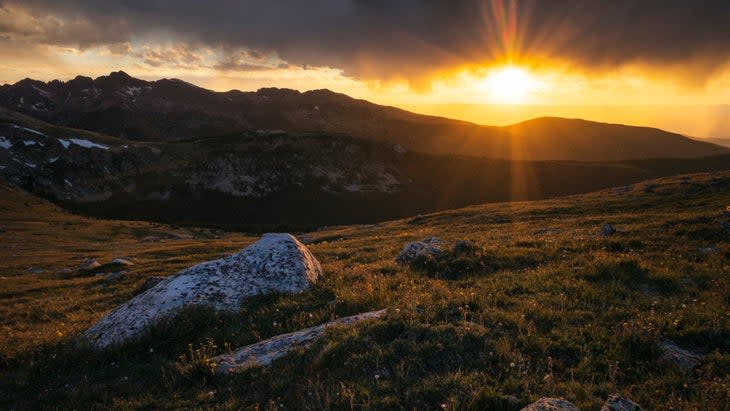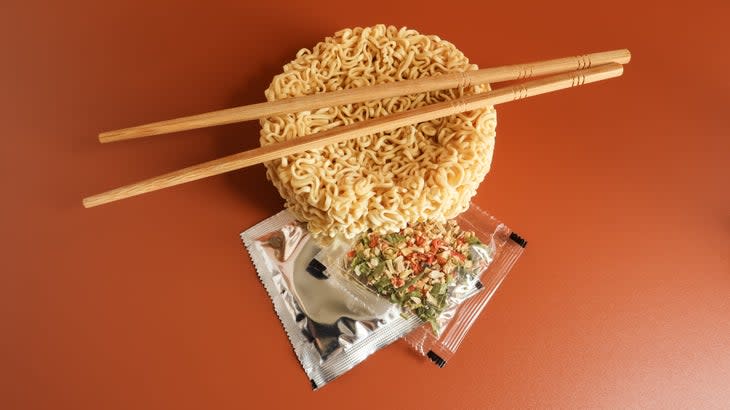5 Free or Cheap Ways to Cut Your Pack Weight This Summer
This article originally appeared on Backpacker
If you're ultralight-curious, there's no better time to try cutting your pack weight than the summer. Consider: Better weather (well, warmer weather, anyway) means fewer just-in-case layers and no need to consider how your tarp will fare in a sudden snowstorm. Plus, longer days mean more time to futz around with new gear or turn around if things go really south. But not everyone wants to drop hundreds of dollars on a style of backpacking that they may or may not even like.
The good news: Ultralight hiking is as much about what you leave behind as what you bring. By making a few cheap substitutions and being smart about what you leave at home, you can drastically lighten your gear during the warmer months. These five Backpacker-tested tips will get you started.
Ditch the Tent
Leaving your tent behind is a shortcut to shedding pack weight--it's probably the heaviest piece of gear in your pack, after all. But it's also one of the most important to your comfort and safety, so ditching it takes some planning.
Your best bet for a first cowboy-camping expedition: the desert. Dry climes not only have less ambient moisture, what precipitation they do get is often a bit more predictable than temperate areas. And while hotter spots come with their own hazards in the summer (avoid exposed trails, double-check the condition of water sources with a ranger or someone knowledgeable, and be ready to cancel if temperatures get dangerously high), they also mean you'll dry off more quickly if you do get caught in a shower. Toss a mylar space blanket in your pack as extra insurance.
Not quite confident enough to camp without shelter? Carrying a tarp is a great way to slash your pack weight without buying a pricey ultralight tent. (REI's Trailbreak Tarp can pitch between two trees or on your trekking poles, and is on sale now for less than $50.) Just make sure you practice setting it up before you leave, and be aware: It won't keep the summer bugs away.
Ditch the Sleeping Bag
Sure, that three-season sleeping bag you bought will work in summer. But that doesn't mean you need to lug it around: Insulating for fall and spring's lower temperatures means extra down--and extra pounds. If you have the cash, the easiest response is to spring for a summer-weight bag or quilt like the 1-pound Big Agnes Pluton UL 40 ($350). If you're not ready to dedicate that kind of money to your quiver, however, you still have options.
One possibility: Spring for an insulated camp blanket instead. While they're draftier than quilts, synthetic or down blankets are light and are often more than enough for warm summer nights. I've used Therm-a-Rest's synthetic-fill Argo Blanket (1 lb. 10 oz.; on sale for $88) as my only sleeping solution on summer overnights in Iowa's Loess Hills and a multiday trip through Panama's mountains. A set of snaps and a drawstring around the top let you cinch it up sleeping bag-style for brisker nights, or you can unfold it and share it with a partner for a sleeping solution that weighs less than a pound per person. I've found it comfortable in overnight lows down to the high 50s, especially paired with a light insulated layer; the 56-inch-wide Stellar Blanket (1 l.b 6 oz.; on sale for $70) is a lighter, smaller option if you plan on going solo.
Ditch the Stove
Cold-soaking is an easy, straightforward way to take a piece of gear off your packing list, but it's also one that a lot of backpackers grow to regret: Choking down your third cold meal of the day is a tough swallow when all you want is a warm, comforting bowl of mac and cheese. One way to make it more pleasant: Ease your way in during your summer trips when you may not crave hot food anyway. Stack the odds of a pleasant trip by planning in advance: While you can cold-soak most commercially freeze-dried meals, you'll have a better time by planning a menu specifically designed to be eaten cold. Start with these three simple, relatively inexpensive recipes.

Embrace the Long Days
It's easy to understand how longer days can help lighten your pack: The more hours of daylight there are, the more miles you can hike; the more miles you can hike, the shorter your trip is; the shorter your trip is, the less food you need to carry. But even for those of us who don't like to rush can benefit from summer's increased daylight hours. As our ultralight columnist Nathan Pipenberg notes, most hikers stick to the same schedule on the trail that they do at home: An early breakfast, a quick lunch, and a long, hearty dinner after dark. The problem is, that strategy leaves you sitting still during the coldest parts of the day, requiring you to carry extra layers to keep you warm.
Instead, he suggests that hikers try scheduling their day like an ultralighter: Get up and start hiking right away, leaving breakfast until temperatures have warmed up. Take a long siesta to eat a hearty meal, digest, and handle filtering your water and other chores around midday. Then, hike through dinner, snacking along the way, and then pitch your shelter and get into your sleeping bag or quilt as soon as you arrive at camp. While you may not want to ditch your insulation entirely for safety's sake, relying on your body heat to keep you warm in place of your sitting-around layers will help you trim ounces from your pack.

Count Your Calories (Per Ounce)
My meal planning has come a long way since my early twenties when, the night before an overnight trip to Arizona's Baboquivari Peak Wilderness, I counted out 2,500 calories of Little Debbie Cosmic Brownies and put them and nothing else in my food bag. But I did learn one important lesson from the iron-stomached adventures of my youth: Sometimes, it's good to eat bad.
Paying attention to how calorie-dense your food is lets you trim ounces from your food bag while still giving yourself the energy to stay moving and comfortable during your trip. And some of the most calorie-dense are the most indulgent: Foods like peanut butter (170 calories/ounce), dark chocolate (160 calories/ounce), and Parmesan cheese (125 calories/ounce) are on the list, as are more traditional "health foods" like granola and nuts. But the king of all backpacking foods may be the humble instant ramen packet, which, at about 125 calories per ounce, is both energy-filled and a good base for just about anything. (It doesn't hurt that they cold-soak so easily either.) Is it "healthy" or “good for your arteries”? Let your future self--the one who isn't trying to fuel for a 20-mile day--worry about that.
For exclusive access to all of our fitness, gear, adventure, and travel stories, plus discounts on trips, events, and gear, sign up for Outside+ today.

